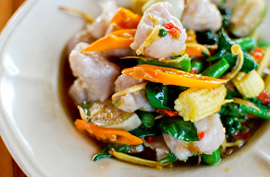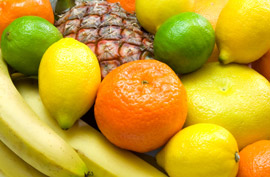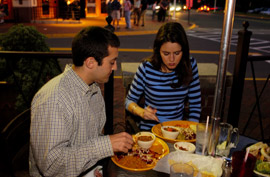 You love to sample foods around the world -- but while your palate may be game, your stomach isn't always up to the challenge. To prevent spending half your trip running to the bathroom, it's important to find a middle ground between sampling local cuisines and treating your belly well.
You love to sample foods around the world -- but while your palate may be game, your stomach isn't always up to the challenge. To prevent spending half your trip running to the bathroom, it's important to find a middle ground between sampling local cuisines and treating your belly well.
First, understand that the food you eat at home isn't necessarily "safer" than food abroad; it's often simply that your body isn't accustomed to it. One important difference between home-grown and foreign foods is the use of more "natural" fertilizers abroad, which can carry bacteria that could cause intestinal distress -- also known as traveler's tummy.
A few of the most common foodborne illnesses include salmonellosis (caused by salmonella bacteria), E. coli infection and norovirus. Outbreaks of these and other foodborne illnesses are monitored by the World Health Organization (WHO) and the Centers for Disease Control and Prevention (CDC); it's worth checking out the websites of these organizations before you travel to see if any of the places you're visiting are currently affected. These sites will also inform you about any ongoing threats you might face where you're going, such as typhoid or hepatitis.
Your best defense against foodborne illnesses is not to panic, but to use common sense -- and with that in mind, we've compiled these tips for eating well and eating safely no matter where you travel.
The most common source of dietary problems while traveling is drinking water, including ice. See Drinking Water Safety for more info.
Cold meat platters, cheese, buffet foods and unsealed mayonnaise are often home to rampant bacteria.
Seafood dishes are notorious for causing intestinal problems, as fish accumulate contaminants from a wide variety of sources. Smaller fish tend to be safer. Fish organs and shellfish (such as clams, mussels and oysters) are usually best avoided.
Steer clear of unpasteurized dairy products, including cheese and yogurt. Check labels for evidence of pasteurization; most canned milk is safe.
Nuts and other shelled foods are usually a good choice.
Coffee and tea are generally harmless, but it's best to take your hot drinks black, without potentially contaminated milk. Cream from sealed containers, if pasteurized, is usually safe.
 The traveler's mantra, attributed to colonial explorers, goes something like this: "Cook it, wash it, peel it or forget it." Freshly cooked foods are less likely to acquire airborne contaminants, and raw foods such as salads, and fruits and vegetables without peels, are often likely culprits for trouble. Fruits and vegetables you can peel yourself are usually safe.
The traveler's mantra, attributed to colonial explorers, goes something like this: "Cook it, wash it, peel it or forget it." Freshly cooked foods are less likely to acquire airborne contaminants, and raw foods such as salads, and fruits and vegetables without peels, are often likely culprits for trouble. Fruits and vegetables you can peel yourself are usually safe.
Condiments such as mayonnaise, ketchup and salad dressings are safest in sealed packages.
Order portions "well done" or at least "medium well," and eat them only if served hot. Be careful especially of runny eggs and sandwiches with lots of raw vegetables.
Beer and wine in other countries may contain more or less alcohol content than in the United States. Pay attention to the effects of all drinks. Moderation is the safest course of action.
 Seven Strange Foods from Around the World
Seven Strange Foods from Around the World
It may be convenient, but it's often risky to purchase food from street vendors. Be sure your dish is served hot, and take a look at the cart or kiosk before ordering. Does it look clean and well kept? Is it busy? (The fewer the customers, the longer the food may sit before being served.)
When choosing a restaurant, our advice is similar: Go with the people flow. Busy restaurants typically serve fresh, clean and safe food. Still, ask that your meal be cooked well, and take normal precautions. If you're in a non-English-speaking country, it's a good idea to have a phrasebook on hand to help translate the menu and avoid potentially risky dishes.
One other bit of advice, straight from the mouths of moms everywhere: Wash your hands before you eat. Keep in mind that you must use "safe" water to wash not only your hands but also any foods you're preparing.
 Get Our Best Travel Deals and Tips!
Get Our Best Travel Deals and Tips!
Those most at risk for foodborne illness are the pregnant, the elderly and those with weakened immune systems. However, being on the road can be rough on even the healthiest travelers. In the midst of dashing from one place to the next, it's easy to neglect proper nutrition; following irregular eating schedules or existing for days on the same foods can compromise the immune system and cause a cascade of health problems. Try to maintain a well-balanced diet. In the absence of meat, you can find protein in eggs, nuts, lentils and tofu. Peelable fruit and vegetables are a good source of trace minerals and vitamins. Make sure your diet includes breads and grains such as rice. Stay hydrated by drinking lots of (safe) water.
Supplements and vitamins, including iron pills, can help maintain balance when your diet is insufficient. Also, "sports bars" such as Balance or Power Bars are excellent, nutrient-packed travel snacks.
 Six Tips for Dining Abroad
Six Tips for Dining Abroad
 The vegetarian lifestyle has moved into the mainstream in many parts of the world, and vegetarian sections have become common on restaurant menus. However, be careful of any entree that is not specifically marked as vegetarian, especially in places such as South America, where beef and other meats are important staples. In these cases, you may explain to a waiter that you do not eat meat, and yet be served lasagna made with meat sauce. Be aware that sauces and soups are often made with meat stock. Buying your own food at a grocery store is often your best option.
The vegetarian lifestyle has moved into the mainstream in many parts of the world, and vegetarian sections have become common on restaurant menus. However, be careful of any entree that is not specifically marked as vegetarian, especially in places such as South America, where beef and other meats are important staples. In these cases, you may explain to a waiter that you do not eat meat, and yet be served lasagna made with meat sauce. Be aware that sauces and soups are often made with meat stock. Buying your own food at a grocery store is often your best option.
If you have allergies or food intolerances, or are on a special diet (low sugar, low calorie, etc.), it's especially important that you have a phrasebook to help you decipher foreign language menus. Like vegetarians, you may want to consider purchasing your own food at a grocery store.
For more information, see Traveling with Dietary Restrictions.